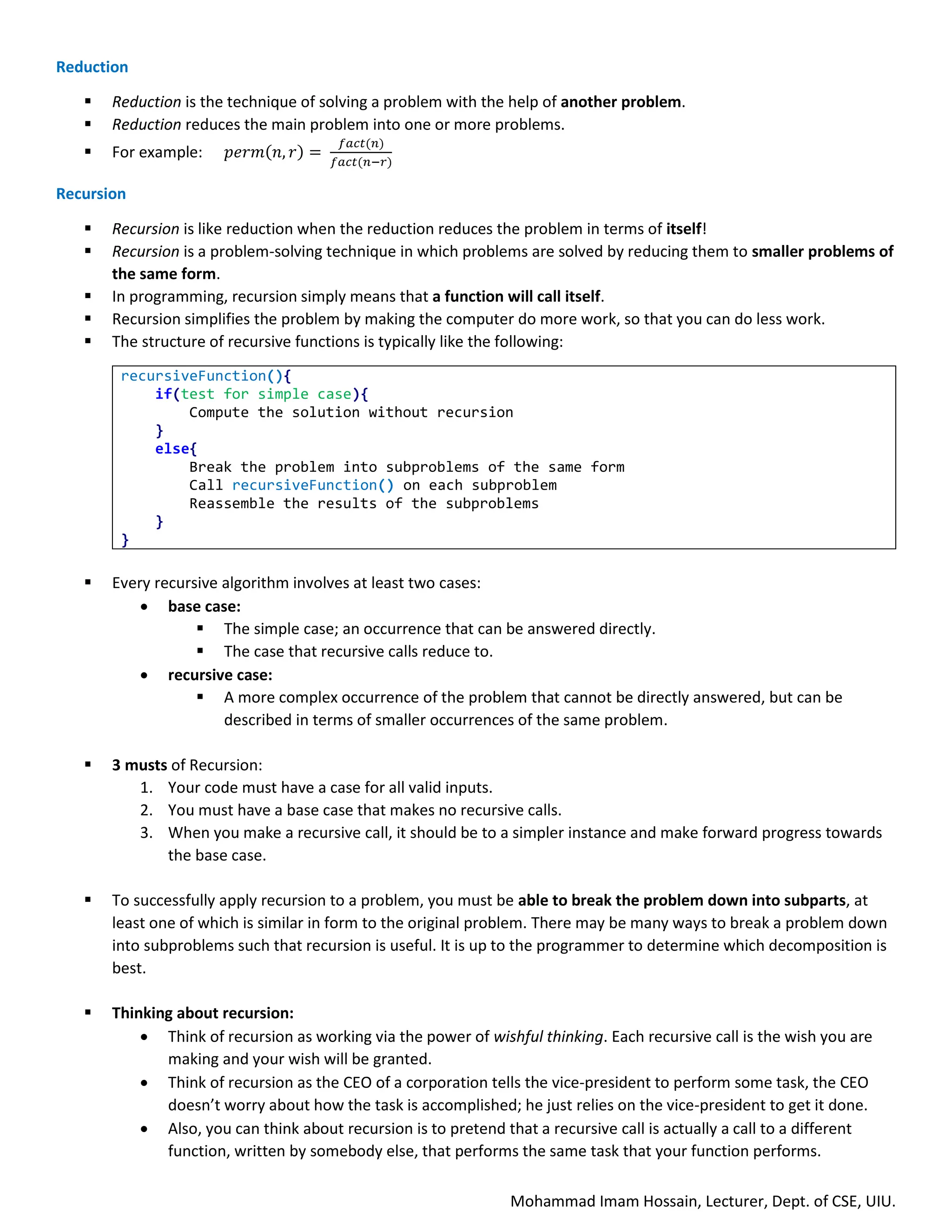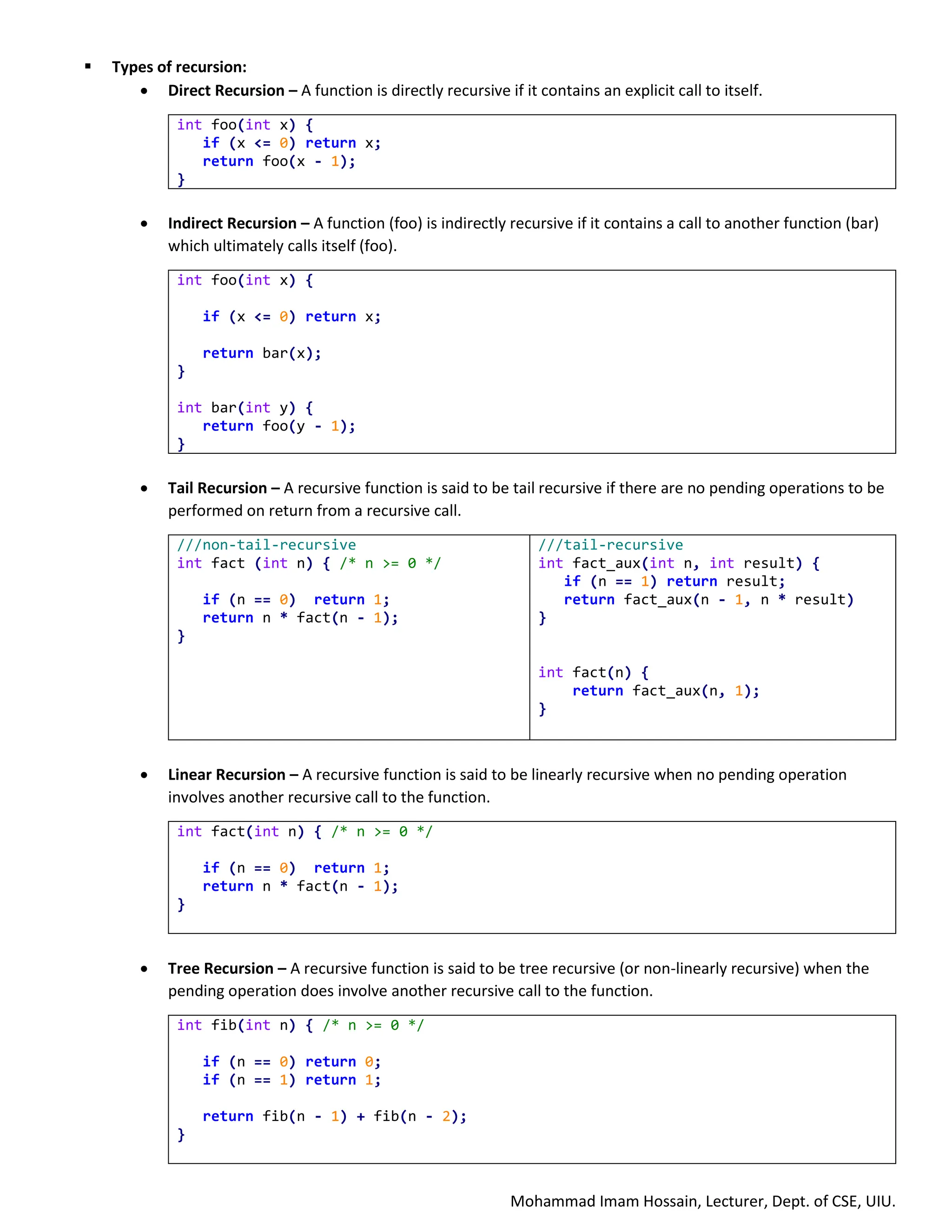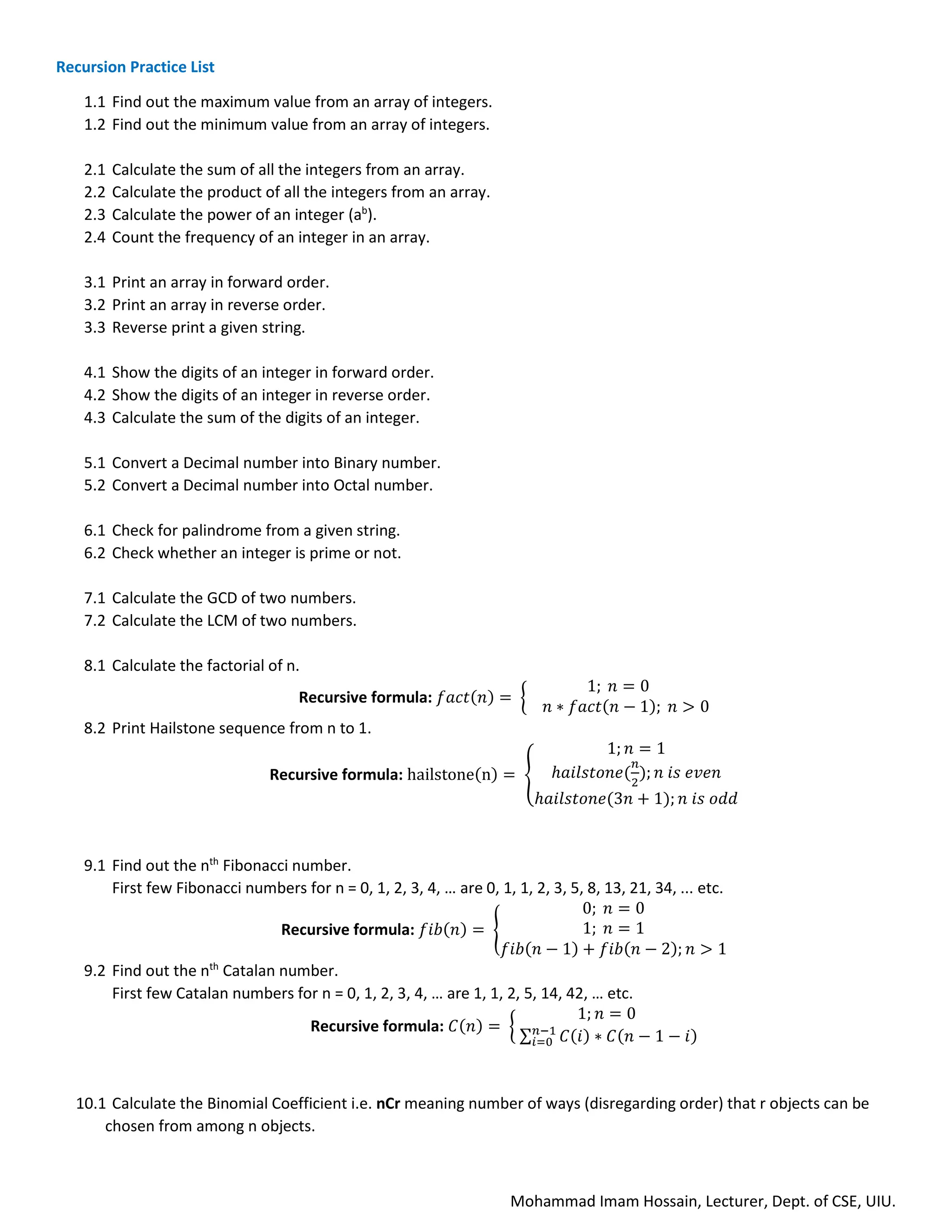The document discusses recursion, defining it as a problem-solving technique where problems are solved by reducing them to smaller problems of the same type. It provides examples of different types of recursion like direct, indirect, tail, and tree recursion. It also lists 15 recursive problems and their solutions including finding maximum/minimum in an array, calculating factorials, Fibonacci numbers, and solving subset sum and coin change problems.




![Mohammad Imam Hossain, Lecturer, Dept. of CSE, UIU.
Recursive formula: 𝐶(𝑛, 𝑟) = {
1; 𝑟 = 0
1; 𝑛 = 𝑟
𝐶(𝑛 − 1, 𝑟) + 𝐶(𝑛 − 1, 𝑟 − 1)
10.2 Calculate the Permutation Coefficient i.e. nPr meaning the number of ways to obtain an ordered subset having k
elements from a set of n elements.
Recursive formula: 𝑃(𝑛, 𝑟) = {
1; 𝑟 = 0
0; 𝑛 < 𝑟
𝑃(𝑛 − 1, 𝑟) + 𝑟 ∗ 𝑃(𝑛 − 1, 𝑟 − 1)
10.3 Count the total number of moves necessary in Tower of Hanoi problem for n disks.
Recursive formula:
𝑇(𝑛, 𝑠𝑟𝑐, 𝑑𝑒𝑠𝑡, 𝑡𝑚𝑝) = {
1; 𝑛 = 1
𝑇(𝑛 − 1, 𝑠𝑟𝑐, 𝑡𝑚𝑝, 𝑑𝑒𝑠𝑡) + 𝑇(1, 𝑠𝑟𝑐, 𝑑𝑒𝑠𝑡, 𝑡𝑚𝑝) + 𝑇(𝑛 − 1, 𝑡𝑚𝑝, 𝑑𝑒𝑠𝑡, 𝑠𝑟𝑐)
11.1 Preorder, Postorder and Inorder binary tree traversal.
11.2 Binary Search Tree search operation.
11.3 Binary Search operation from a sorted array.
12. Tiling Problem — Given a (2 x n) board and tiles of size (2 x 1), count the number of ways to tile the given board
using the tiles. A tile can either be placed horizontally or vertically.
Recursive formula: 𝑇(𝑛) = {
1; 𝑛 = 1
2; 𝑛 = 2
𝑇(𝑛 − 1) + 𝑇(𝑛 − 2)
13. Coin Change Problem — Given a value N, if we want to make change for N cents, and we have infinite supply of
each of C = {C1, C2, C3, …, CN} valued coins, how many ways can we make the change? The order of coins doesn’t
matter.
Recursive formula:
𝐶(𝑐𝑜𝑖𝑛𝑠[], 𝑠𝑧, 𝑎𝑚𝑜𝑢𝑛𝑡) = {
1; 𝑎𝑚𝑜𝑢𝑛𝑡 = 0
0; 𝑎𝑚𝑜𝑢𝑛𝑡 < 0
0; 𝑎𝑚𝑜𝑢𝑛𝑡 > 0 𝑎𝑛𝑑 𝑠𝑧 = 0
𝐶(𝑐𝑜𝑖𝑛𝑠[], 𝑠𝑧 − 1, 𝑎𝑚𝑜𝑢𝑛𝑡) + 𝐶(𝑐𝑜𝑖𝑛𝑠[], 𝑠𝑧, 𝑎𝑚𝑜𝑢𝑛𝑡 − 𝑐𝑜𝑖𝑛_𝑣𝑎𝑙𝑢𝑒)
14. Friends Pairing Problem – Given n friends, each one can remain single or can be paired up with some other
friend. Each friend can be paired only once. Find out the total number of ways in which friends can remain single
or can be paired up.
Recursive formula: 𝐹𝑃(𝑛) = {
1; 𝑛 = 1
2; 𝑛 = 2
𝐹𝑃(𝑛 − 1) + (𝑛 − 1) ∗ 𝐹𝑃(𝑛 − 2)
15. Subset Sum Problem – Given a set of non-negative integers, and a value sum, determine if there is a subset of
the given set with sum equal to given sum.
Recursive formula: 𝑆(𝑠𝑒𝑡[], 𝑠𝑧, 𝑠𝑢𝑚) = {
𝑡𝑟𝑢𝑒; 𝑠𝑢𝑚 = 0
𝑓𝑎𝑙𝑠𝑒; 𝑠𝑢𝑚 < 0
𝑓𝑎𝑙𝑠𝑒; 𝑠𝑢𝑚 > 0 𝑎𝑛𝑑 𝑠𝑧 = 0
𝑆(𝑠𝑒𝑡[], 𝑠𝑧 − 1, 𝑠𝑢𝑚) || 𝑆(𝑠𝑒𝑡[], 𝑠𝑧 − 1, 𝑠𝑢𝑚 − 𝑐𝑜𝑛𝑠𝑖𝑑𝑒𝑟𝑒𝑑𝑉𝑎𝑙𝑢𝑒)](https://image.slidesharecdn.com/recursionlecture-231010155917-aecf2fec/75/DS-Algo-2-Recursion-5-2048.jpg)